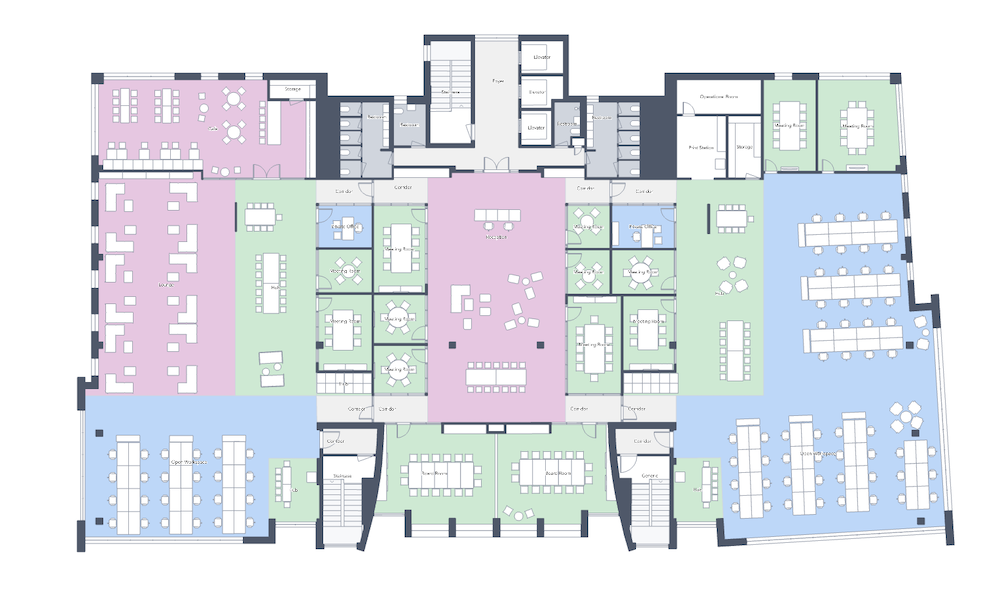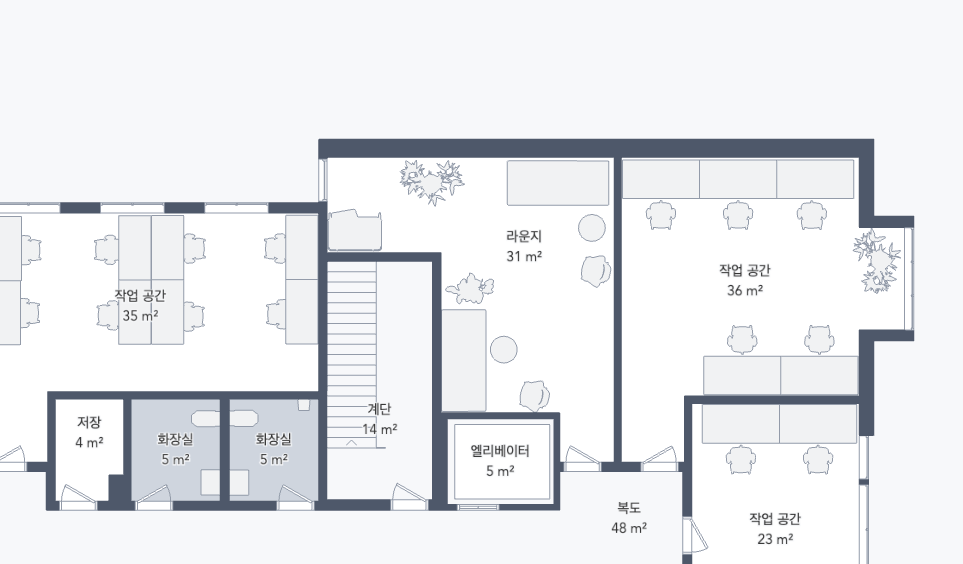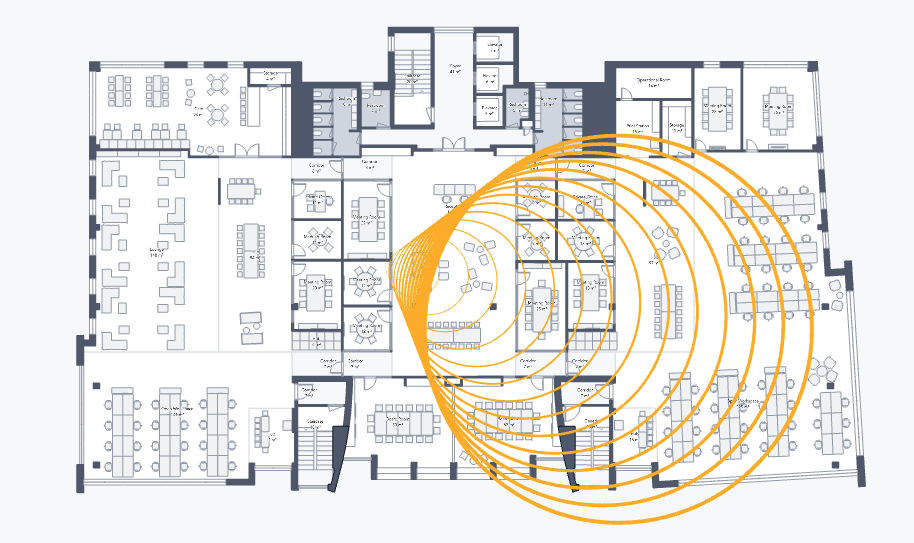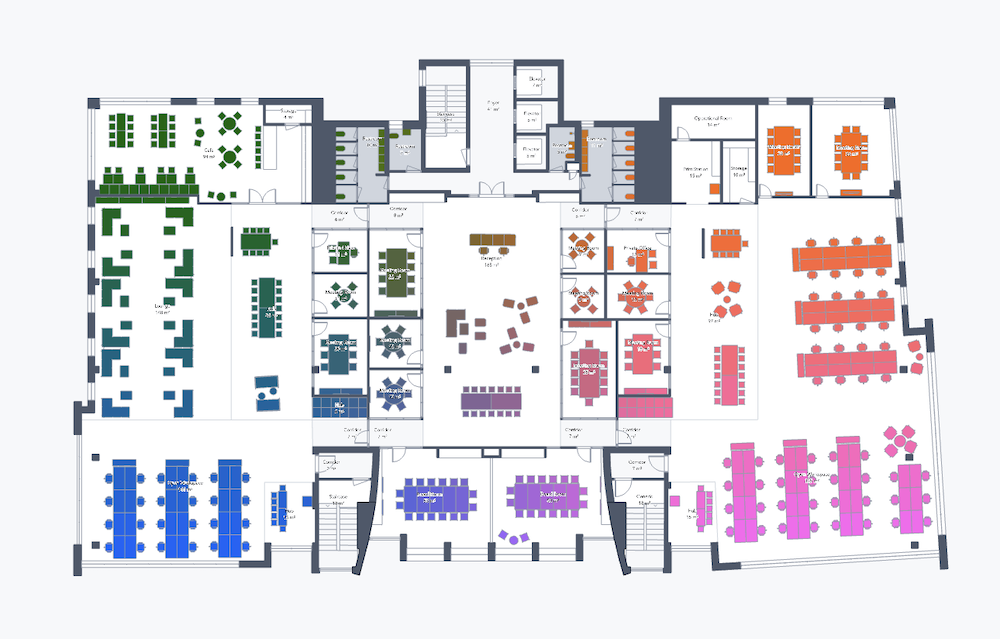Appearance
Floor Plan SDK guide
A modern Typescript SDK for dynamic display of floor plans
INFO
This page documents Floor Plan SDK v5, which requires Space Graph.
Looking for the older v3 version or information on migration?
Overview
The Floor Plan SDK enables you to create interactive, customizable floor plan models embedded in your website using JavaScript or TypeScript.
Interactive example (you can zoom or pan the plan):
Quick start
Install the Floor Plan SDK JS package via npm.
bash
npm install @archilogic/floor-plan-sdkYou can then import it into your project:
html
<div id="floor-plan"></div>ts
import '@archilogic/floor-plan-sdk/dist/style.css'
import { FloorPlanEngine } from '@archilogic/floor-plan-sdk'
const container = document.getElementById('floor-plan')
const floorPlan = new FloorPlanEngine({ container })
// Create publishable access token at https://app.archilogic.com/organization/settings/access-tokens
const publishableAccessToken = '<your-token>'
const floorId = '<your-floor-id>'
floorPlan.loadFloorById(floorId, { publishableAccessToken }) Open code sample on StackBlitz 
Startup Options
The FloorPlanEngine has an optional parameter options. See below the various options that can be set through this parameter. The options are passed like the following:
js
new FloorPlanEngine({ container, options })Options can be changed at runtime using the set method
js
floorPlan.set(options)Theme
The SDK offers a wide range of theming options.
Spaces can be colored programmatically following the Space Taxonomy. The following snippet colors all work spaces blue.
js
const options = {
theme: {
elements: {
'layout:space': {
program: {
work: { fill: [214, 234, 248] }
}
}
}
}
}
const floorPlan = new FloorPlanEngine({ container, options })
floorPlan.loadFloorById(floorId, { publishableAccessToken })ts
import type { FpeConfig } from '@archilogic/floor-plan-sdk'
const options: FpeConfig = {
theme: {
elements: {
'layout:space': {
program: {
work: { fill: [214, 234, 248] }
}
}
}
}
}
const floorPlan = new FloorPlanEngine({ container, options })
floorPlan.loadFloorById(floorId, { publishableAccessToken }) Open code sample on StackBlitz 

Custom room stamp content
roomStampDisplay allows to set the properties and their order for all room stamps shown in the floor plan.
The default value is ['usage', 'area'].
js
const attributeId = 'department-name'
const options = {
theme: {
elements: {
roomStamp: {
roomStampDisplay: ['name', 'customId', 'usage', 'area', ['customAttribute', attributeId]]
}
}
}
}
const floorPlan = new FloorPlanEngine({ container, options })
floorPlan.loadFloorById(floorId, { publishableAccessToken })ts
import type { FpeConfig } from '@archilogic/floor-plan-sdk'
const attributeId = 'department-name'
const options: FpeConfig = {
theme: {
elements: {
roomStamp: {
roomStampDisplay: ['name', 'customId', 'usage', 'area', ['customAttribute', attributeId]]
}
}
}
}
const floorPlan = new FloorPlanEngine({ container, options })
floorPlan.loadFloorById(floorId, { publishableAccessToken })To set a name, customId for a space, you can use the Archilogic Editor.
Custom attributes are user defined properties, that can be defined for an organisation in the Dashboard or via API and then edited in the Editor.
Space label mapping
Map space labels by space usage or space id. Refer to the space taxonomy for reference.
js
const options = {
spaceLabelMapping: {
meetingRoom: '회의실'
}
}
const floorPlan = new FloorPlanEngine({ container, options })
floorPlan.loadFloorById(demoSceneId, { publishableAccessToken }) Open code sample on StackBlitz 

Resources
When the promise returned by loadFloorById is resolved, we can expect that the layout.spaces and layout.elements are populated with the Space and Asset nodes. Each space references the assets that it contains by their unique id. This allows you to know what's in each space.
Space
Sample space:
ts
await floorPlan.loadFloorById('a9aaafdf-d5b6-4b4a-82a0-9efb6d5b155a', { publishableAccessToken })
const space: LayoutSpace = floorPlan.layout.spaces[0]
class LayoutSpace {
type: "layout:space"
// unique id for the space
id: string
// custom name
name: string
// custom id
customId: string
attributes: {
// assigned usage function
usage: string
// space category
program: string
}
// get the contained assets in the space
getElements('element:asset'): LayoutAsset[]
}Visit the Space Graph documentation for more details and the space taxonomy.
Asset
Sample asset:
ts
// get an asset that is referenced by the space above
const asset: LayoutAsset = floorPlan.layout.elementsById[assetId]
class LayoutAsset {
type: 'element:asset'
// unique id for the asset
id: string
// [x, y, z] - right handed coordinate system, y is up
position: Vector3
// rotation around the y axis in degrees
rotation: number
// multiple assets can reference the same product definition
product: SpaceGraphProduct
// get the space the asset is in
getSpaces(): LayoutSpace[]
}
class SpaceGraphProduct {
id: string
// product metadata (generic or real)
name: string
attributes: {
// product category
categories: string[]
// product subCategory
subCategories: string[]
// product dimensions
boundingBox: BoundingBox3d
}
}Take a look at the product taxonomy for reference. And visit the Space Graph documentation for more details.
Events
The FloorPlanEngine instance exposes a few useful events
Subscribe
js
floorPlan.on(event, callback, context)Subscribe for one event
js
floorPlan.once(event, callback, context)Unsubscribe
js
floorPlan.off(event, callback)click
Mouse click or touch event.
Instead of click you can also listen for dblclick
js
// returns the plan position, the sourceEvent and if present the id of the node that you clicked on
floorPlan.on('click', onClick)
function onClick({ position, sourceEvent, nodeId }) {
// to get the top resource that was clicked on use the nodeId
const asset = floorPlan.layout.elementsById[nodeId]
const space = floorPlan.layout.spacesById[nodeId]
// to get all resources for that position use the position
const { assets, spaces } = floorPlan.getResourcesFromPosition(position)
}ts
import type { FpePointerEvent } from '@archilogic/floor-plan-sdk'
// returns the plan position, the sourceEvent and if present the id of the node that you clicked on
floorPlan.on('click', onClick)
function onClick({ position, sourceEvent, nodeId }: FpePointerEvent) {
// to get the top resource that was clicked on use the nodeId
const asset = nodeId && floorPlan.layout.elementsById[nodeId]
const space = nodeId && floorPlan.layout.spacesById[nodeId]
// to get all resources for that position use the position
const { assets, spaces } = floorPlan.getResourcesFromPosition(position)
}mousemove
Fired when moving the mouse
js
floorPlan.on('mousemove', onMouseMove)
function onMouseMove({ position, sourceEvent, nodeId }) {
// ...
}ts
import type { FpePointerEvent } from '@archilogic/floor-plan-sdk'
floorPlan.on('mousemove', onMouseMove)
function onMouseMove({ position, sourceEvent, nodeId }: FpePointerEvent) {
// ...
}drop
Fired when dropping a draggable Element on the canvas
js
floorPlan.on('drop', onDrop)
function onDrop({ position, sourceEvent, nodeId }) {
// ...
}ts
import type { FpeDropEvent } from '@archilogic/floor-plan-sdk'
floorPlan.on('drop', onDrop)
function onDrop({ position, sourceEvent }: FpeDropEvent) {
// ...
}loading done
Fired when loading is done and the floor is rendered. This is an alternative to awaiting the promise of floorPlan.loadFloorById().
js
floorPlan.on('loading-done', onLoadingDone)
function onLoadingDone() {
// ...
}Zoom
The SDK provides various zoom methods
Zoom extents
Allows you to zoom to the extent of the scene, with a specified margin using zoomExtents.
Zoom to element
You can also zoom into an element (space, asset) with or without animation using the zoomToElement method.
js
// get a space ID
const spaceId = floorPlan.layout.spaces[0].id
// zoom to the space with 2m margin and 500ms animation time
floorPlan.zoomToElement(spaceId, 2, 500) Open code sample on StackBlitz 
Zoom by factor
Zoom the current view by a factor with zoomByFactor. A zoom factor, larger than 1 zooms in, smaller than 1 zooms out.
js
floorPlan.zoomByFactor(1.2, true)Set zoom
Set the view box by providing a bounding box using the setZoom method.
Methods
Add marker
The addMarker method can be used to add extra information to a given location within the floor plan. It requires the following parameters:
ts
floorPlan.addMarker({
position: [7, 2],
color: '#0c9'
})Where
positionis the position on the floor plan specified in meters where the info window pointswidth,heightspecifies the size of the info window
Returns Marker instance
Add info window
The addInfoWindow method can be used to add extra information to a given location within the floor plan. It requires the following parameters:
ts
floorPlan.addInfoWindow({
position: [7, 2],
width: 200,
height: 80,
html: '<h1>Note</h1><p>This room has 3 desks</p>',
closeButton: true
})Where
positionis the position on the floor plan specified in meters where the info window pointswidth,heightspecifies the size of the info windowhtmlis the user-specified content to be displayedcloseButtoniftruedisplays a close button
Returns InfoWindow instance
Add Html marker
The addHtmlMarker method can be used to add extra information to a given location within the floor plan. It requires the following parameters:
ts
const el = document.createElement('div')
el.classList.add('my-marker')
floorPlan.addHtmlMarker({
position: [7, 2],
el
})Where
positionis the position on the floor plan specified in meters where the info window pointselis the HTML Element that you want to mount at that position
Returns Html Marker instance
Add layer and graphics
js
const layer = floorPlan.addLayer({ id: 'circles' })
const list = Array.from({ length: 15 }, (_, i) => i + 1)
layer.addGraphic({
shapes: list.map(radius => ({
type: 'curve:circle',
radius,
position: [0, 0],
style: { stroke: '#ffab00', strokeWidth: radius * 2 }
}))
})ts
import type { Shape } from '@archilogic/floor-plan-sdk'
const layer = floorPlan.addLayer({ id: 'circles' })
const list: number[] = Array.from({ length: 15 }, (_, i) => i + 1)
layer.addGraphic({
shapes: list.map<Shape>(radius => ({
type: 'curve:circle',
radius,
position: [0, 0],
style: { stroke: '#ffab00', strokeWidth: radius * 2 }
}))
}) Open code sample on StackBlitz 

Get resources from position
From a given plan position the getResourcesFromPosition methods returns the assets and spaces for that position.
js
floorPlan.on('click', handleClick, floorPlan)
function handleClick(evt) {
// returns the plan position, the sourceEvent and if present the id of the node that you clicked on
const { position, sourceEvent, nodeId } = evt
// get a list of assets and spaces for that plan position
const { assets, spaces } = this.getResourcesFromPosition(position)
// proceed by highlighting the resources in focus for instance
}Highlight a resource
All exposed resources can be colored programmatically floorPlan.drawNodeUpdate
js
// use the setHighlight method to temporarily change its color and its outline
floorPlan.drawNodeUpdate('<node-id>', {
fill: [236, 112, 99],
stroke: [200, 42, 25],
strokeWidth: 2
})
// use the same method to reset the color
floorPlan.drawNodeUpdate('<node-id>', false)Example
Color all assets based on their position
ts
const floorPlan = new FloorPlanEngine({ container })
floorPlan.loadFloorById(floorId, { publishableAccessToken }).then(() => {
highlightNodes()
})
function highlightNodes() {
for (const asset of floorPlan.layout.elementsByType['element:asset']) {
const { position } = asset.getWorldTransform()
floorPlan.drawNodeUpdate(asset.id, {
fill: position.map(n => Math.min(255, Math.max(0, Math.round(n) * 10)))
})
}
} Open code sample on StackBlitz 

Save floor plan as image
A method is provided to save the displayed floor plan as either jpg of png image: exportImage
js
floorPlan.exportImage({
download: true,
format: 'jpg'
})
